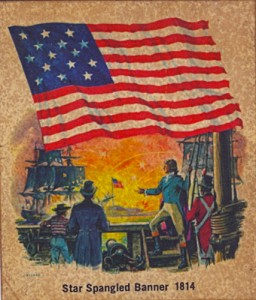
Two hundred years ago, an epic American tale of endurance and honor occurred, one of the most famous events in American history and no doubt the most famous event in the War of 1812: the siege of Fort McHenry and the writing of the “Star Spangled Banner” by Francis Scott Key. The siege of Fort McHenry was part of the Battle of Baltimore during the final, waning months of the War of 1812. The British had invaded Maryland in order to gain leverage in the peace talks that were imminent. They had sacked Washington D.C., burning the White House and Congress. They had defeated American troops at the Battle of Bladensburg where they used Congreve rockets to induce havoc on the American lines.
When the British advanced on Baltimore, “a pirates’ nest”, they were met with American defenders at North Point. The Americans were successful in delaying the British here and at Hampstead Hill. The most famous part of the battle was at Fort McHenry, however. It is was here that the British navy bombarded the fort which held the key to Baltimore.
All of the dramatic night’s events were observed by a young lawyer named Francis Scott Key who was on board a British vessel to negotiate the release of an American doctor. He wrote a poem afterwards about the events of the night and the fortitude of the defenders of the fort, which did not surrender despite a furious bombing. “O say can you see by the dawn’s early light, What so proudly we hailed at the twilight’s last gleaming, Whose broad stripes and bright stars through the perilous fight, O’er the ramparts we watched, were so gallantly streaming?” Through the rockets’ red glare and the bombs bursting in air, Key could see the American flag still flying over the fort. The anxious American prisoners also aboard the ship asked Key desperately what was going on. Key replied that the flag was “still there”. The men below prayed for the defenders of the fort as they came under heavy fire. Indeed, the phrase “In God We Trust” originated in Key’s poem before becoming an integral motto for Americans. In the end, the fort stood, the flag stood and the British were repelled from Baltimore. It was the dead bodies of American patriots that held that flag up. As the fort fell under heavy and constant barrage the soldiers inside died holding their nation’s flag high above the ramparts.
As we all know, the poem was made into the American national anthem. The song reminds us of the determination and honor of the American Republic and that the Star Spangled Banner will still wave “o’er the Land of the free and the Home of the Brave.” Two hundred years have past since that great and dreadfully courageous day but the American virtues of fortitude and liberty remain and yes, the Star Spangled Banner yet waves. The flag has waved over Iwo Jima and Ground Zero. But we must remember that it does not stand by itself. The Star-Spangled Banner is held up by the sacrifice of American heroes who have resolved to keep it flying and by the grace of God.
